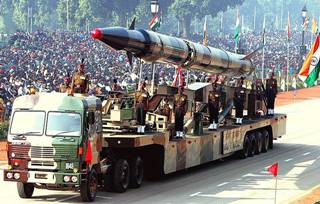|
Balasore, Orissa: Indian defence scientists and Indian Army officials are working towards conducting a user trial of the country's medium range ballistic missile, the Agni-II, sometime between 3-8 November this year. The Agni-II, a nuclear capable missile, can hit targets beyond 2,000 km and up to a distance of 3,500 km with varying payloads. ''The missile is scheduled to be fired from the Wheelers Island based test range facilities any time between November 3 and 8,'' defence sources said.  According to scientists, the 700-km range Agni-I along with the 2000+ km range Agni-II and the 3000+ km range Agni-III form the triad of the country's nuclear deterrence. According to scientists, the 700-km range Agni-I along with the 2000+ km range Agni-II and the 3000+ km range Agni-III form the triad of the country's nuclear deterrence.
The Agni-II missile, whose first operational variant was test-fired in April 1999, is 20-meter long and 1.3 meter in diameter. Weighing 16 tonnes it is designed to carry a nuclear payload of about 1,000 kg to a distance in excess of 2500 km. The previous user trial conducted on 19 May this year was not a success. The missile has already been inducted into the Indian Army's 555 missile group. Agni-II
Agni-II is a ready-to-fire missile with a launch time of about 15 minutes. The missile is unique in that its second stage has a flex nozzle which enables small changes in the thrust vector direction in flight allowing far superior manoeuvrability and thrust control than any comparable missiles in its class, including western ones. The flex nozzle can be exploited with the help of an on-board closed-loop guidance and control system. Till now, the flex nozzle has been used only in the third-stage motor of the PSLV. The missile's re-entry vehicle uses its manoeuvring fins to porpoise the warhead, to avoid missile defences while manoeuvring to its target, employing terminal guidance radar operating in the C- and S-bands. The Agni-II is designed to be launched from a rail-mobile launcher; one that can move on a standard broad-gauge rail system. It is also road-mobile and the services can choose which system they want. A rail- and/or road-based missile system reduces vulnerability and allows for greater operational flexibility. While India's is mostly covered with road and rail infrastructure in most parts of the country except the north-east which has more rail and less road infrastructure, the missile's rail mobility means that in strategic terms its deployment in this part of the country is a serious possibility. Deployment here will allow the missile to hit deeper into China, though without reaching important city and industrial centres such as Beijing, which are 3000+ km away. While earlier test versions of the missile had a CEP of ±100 metres, the latest versions will have a CEP of around 30 metres. Indian scientists such as BrahMos Aerospace chief Dr A Sivathanu Pillai have said that the missile would have a unique on-board energy management system and an on-flight guidance process using navigational sensor technology.
|